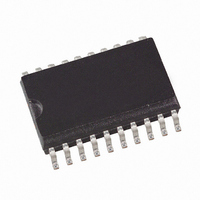ATA5743P3-TKSY Atmel, ATA5743P3-TKSY Datasheet - Page 14

ATA5743P3-TKSY
Manufacturer Part Number
ATA5743P3-TKSY
Description
IC RCVR ASK/FSK 300KHZ 20SSOP
Manufacturer
Atmel
Datasheet
1.ATA5743P3-TGQY.pdf
(43 pages)
Specifications of ATA5743P3-TKSY
Frequency
300MHz ~ 450MHz
Sensitivity
-110dBm
Data Rate - Maximum
10 kBaud
Modulation Or Protocol
ASK, FSK
Applications
RKE, Telemetering, Security Technology
Current - Receiving
7.5mA
Data Interface
PCB, Surface Mount
Antenna Connector
PCB, Surface Mount
Voltage - Supply
4.5 V ~ 5.5 V
Operating Temperature
-40°C ~ 105°C
Package / Case
20-SOIC (0.200", 5.30mm Width)
Operating Frequency (max)
450000kHz
Operating Temperature (min)
-40C
Operating Temperature (max)
105C
Operating Temperature Classification
Industrial
Product Depth (mm)
4.4mm
Operating Supply Voltage (min)
4.5V
Operating Supply Voltage (typ)
5V
Operating Supply Voltage (max)
5.5V
Lead Free Status / RoHS Status
Lead free / RoHS Compliant
Features
-
Memory Size
-
Lead Free Status / Rohs Status
Compliant
Figure 6-3.
6.3.1
6.3.2
14
IC_ACTIVE
Bit check
Dem_out
Data_out (DATA)
(Number of checked Bits: 3)
ATA5743
Bit-check Mode
Configuring the Bit Check
Timing Diagram for Complete Successful Bit Check
Start-up mode
In bit-check mode the incoming data stream is examined to distinguish between a valid signal
from a corresponding transmitter, and signals due to noise. This is done by subsequent time
frame checks where the distances between two signal edges are continuously compared to a
programmable time window. The maximum count of this edge-to-edge test before the receiver
switches to receiving mode is also programmable.
Assuming a modulation scheme that contains two edges per bit, two time frame checks verify
one bit. This is valid for Manchester, Bi-phase, and most other modulation schemes. The maxi-
mum count of bits to be checked can be set to 0, 3, 6 or 9 bits via the variable N
OPMODE register. This implies 0, 6, 12 and 18 edge-to-edge checks, respectively. If N
set to a higher value, the receiver is less likely to switch to receiving mode due to noise. In the
presence of a valid transmitter signal, the bit check takes less time if N
value. In polling mode, the bit-check time is not dependent on N
example where 3 bits are tested successfully and the data signal is transferred to pin DATA.
As demonstrated in
limits. If the edge-to-edge time t
bit-check limit, T
T
Figure 6-4.
For best noise immunity it is recommended to use a low span between T
This is achieved by using a fixed frequency at a 50% duty cycle for the transmitter preburst. For
this reason, a “11111...” or a “10101...” sequence in Manchester or Bi-phase is a good choice. A
good compromise between receiver sensitivity and susceptibility to noise is a time window of
±25% regarding the expected edge-to-edge time t
various edge-to-edge time periods, the bit-check limits must be programmed according to the
required span.
T
Lim_max
Start-up
, the bit check will be terminated and the receiver will switch to sleep mode.
Valid Time Window for Bit Check
Lim_max
Figure
1/2 Bit
Dem_out
, the check will be continued. If t
6-4, the time window for the bit check is defined by two separate time
1/2 Bit
Bit-check mode
ee
T
Bit-check
is between the lower bit-check limit, T
1/2 Bit
T
Lim_min
T
Lim_max
t
Bit check ok
ee
1/2 Bit
1/f
Sig
1/2 Bit
ee
ee
. Using preburst patterns that contain
is smaller than T
1/2 Bit
Bit-check
Receiving mode
Bit-check
.
Lim_min
Lim_min
Figure 6-3
Lim_min
is set to a lower
, and the upper
, or t
4839B–RKE–08/05
and T
Bit-check
ee
shows an
Bit-check
exceeds
Lim_max
in the
is
.














